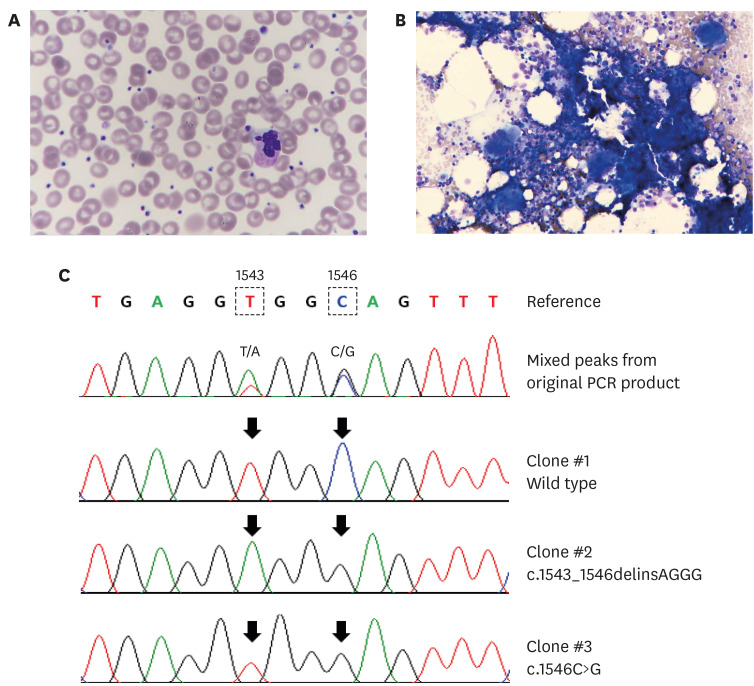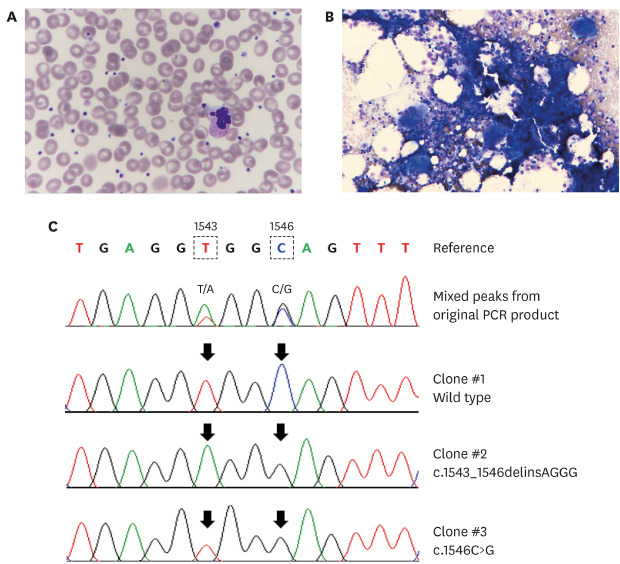1. Swerdlow SH, Campo E, Harris NL, Jaffe ES, Pileri SA, Stein H, et al. WHO Classification of Tumours of Haematopoietic and Lymphoid Tissues. Lyon: IARC;2017.
2. Lim Y, Lee JO, Bang SM. Incidence, survival and prevalence statistics of classical myeloproliferative neoplasm in Korea. J Korean Med Sci. 2016; 31(10):1579–1585. PMID:
27550486.

3. Vainchenker W, Kralovics R. Genetic basis and molecular pathophysiology of classical myeloproliferative neoplasms. Blood. 2017; 129(6):667–679. PMID:
28028029.

4. Mansier O, Luque Paz D, Ianotto JC, Le Bris Y, Chauveau A, Boyer F, et al. Clinical and biological characterization of MPN patients harboring two driver mutations, a French intergroup of myeloproliferative neoplasms (FIM) study. Am J Hematol. 2018; 93(4):E84–E86. PMID:
29266414.

5. De Roeck L, Michaux L, Debackere K, Lierman E, Vandenberghe P, Devos T. Coexisting driver mutations in MPN: clinical and molecular characteristics of a series of 11 patients. Hematology. 2018; 23(10):785–792. PMID:
29993347.

6. Kang MG, Choi HW, Lee JH, Choi YJ, Choi HJ, Shin JH, et al. Coexistence of JAK2 and CALR mutations and their clinical implications in patients with essential thrombocythemia. Oncotarget. 2016; 7(35):57036–57049. PMID:
27486987.

7. Park SH, Chi HS, Cho YU, Jang S, Park CJ, Kim DY, et al. Two cases of myeloproliferative neoplasm with a concurrent JAK2 (V617F) mutation and BCR/ABL translocation without chronic myelogenous leukemia phenotype acquisition during hydroxyurea treatment. Ann Lab Med. 2013; 33(3):229–232. PMID:
23667855.
8. Jeromin S, Kohlmann A, Meggendorfer M, Schindela S, Perglerová K, Nadarajah N, et al. Next-generation deep-sequencing detects multiple clones of CALR mutations in patients with BCR-ABL1 negative MPN. Leukemia. 2016; 30(4):973–976. PMID:
26220041.

9. Kim BH, Cho YU, Bae MH, Jang S, Seo EJ, Chi HS, et al. JAK2 V617F, MPL, and CALR mutations in Korean patients with essential thrombocythemia and primary myelofibrosis. J Korean Med Sci. 2015; 30(7):882–888. PMID:
26130950.

10. Kim SY, Im K, Park SN, Kwon J, Kim JA, Lee DS. CALR, JAK2, and MPL mutation profiles in patients with four different subtypes of myeloproliferative neoplasms: primary myelofibrosis, essential thrombocythemia, polycythemia vera, and myeloproliferative neoplasm, unclassifiable. Am J Clin Pathol. 2015; 143(5):635–644. PMID:
25873496.
11. Nielsen C, Bojesen SE, Nordestgaard BG, Kofoed KF, Birgens HS. JAK2V617F somatic mutation in the general population: myeloproliferative neoplasm development and progression rate. Haematologica. 2014; 99(9):1448–1455. PMID:
24907356.

12. Jang MA, Choi CW. Recent insights regarding the molecular basis of myeloproliferative neoplasms. Korean J Intern Med. 2020; 35(1):1–11. PMID:
31778606.

13. Xie J, Chen X, Gao F, Hou R, Tian T, Zhang Y, et al. Two activating mutations of MPL in triple-negative myeloproliferative neoplasms. Cancer Med. 2019; 8(11):5254–5263. PMID:
31294534.






 PDF
PDF Citation
Citation Print
Print




 XML Download
XML Download